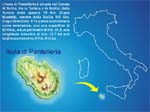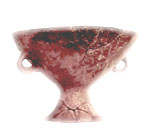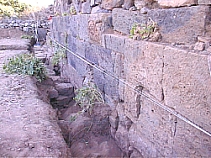|
|
|
|
|
Where we are...
|

|
|
|
How to arrive
|
You can arrive to
Pantelleria from Milan
and Rome by charter
flights...
From Milan, Rome and
Trapani by Airone
flights...
From Palermo by
Meridiana flights...
From Trapani by
Siremar ship...
From Mazara by
Tirrenia ship...
From Trapani by Ustica
Lines speedboat...
[details]
|
|
|
|
|
|
|
|
|
|
|
History of Pantelleria islandThe centrality of its
position in the Mediterranean Sea between Sicily and Africa has greatly influenced the
complexities and radical changes of Pantelleria's long history since it was first settled
in late prehistoric times. The volcanic nature has instead determined its economic bases
up to the buildup of tourism in the present. Alike other small islands in the
Mediterranean, Pantelleria was first visited in Late Mesolithic times,
during the 6th millennium BC, when significant developments in marine
watercraft made possible offshore fishing expeditions and seafaring navigation. settled
in late prehistoric times. The volcanic nature has instead determined its economic bases
up to the buildup of tourism in the present. Alike other small islands in the
Mediterranean, Pantelleria was first visited in Late Mesolithic times,
during the 6th millennium BC, when significant developments in marine
watercraft made possible offshore fishing expeditions and seafaring navigation.
The abundance of obsidian, mainly outcropping along its southern shores,
draw to the island the first settlers in Neolithic times. This black,
shiny volcanic glass was the base resource for the making of tools indespensable to the
earliest farmers around the whole Mediterranean. From its sharp concoid flakes were
produced the ideal blades for sickles and other tools to cut plants. Unfortunately, only
scanty, isolated remains survive in Pantelleria of these earliest periods, buried under
later deposits. Significant improvements of farming and stock-breeding during the 4th
and 3rd millennia BC created the conditions for a permanent and affluent
occupation of all Mediteranean islands. The fertile volcanic soils covering the island
became the main source of wealth of Pantelleria. Along with them obsidian continued to
provide the material for all cutting tools, while vacuolar basalt was quarried to be used
and exported for querns and millstones. By 1800 BC most of the
 island was
occupied by groups of farmers akin to the Early Bronze Age Sicilian cultures. Their most
interesting remains are still visible in the Mursia area: massive
defensive walls, foundations of old houses, overlooked by dozens of megalithic cairn
burials, locally called 'Sesi'. The site remained occupied for most of
the 2nd millennium BC.Sometime during the 9th century BC the island became part
of the Phoenician trade network transecting the whole of the Mediterranean from Lebanon to
the Atlantic. Slowly with the growth of Carthage as the main city and market of the
Central Mediterranean, Pantelleria became more closely related to Africa and the Semite
world. Its first name as known from coins was Yrnm, and later was
changed into Cossyra. A fortified Acropolis was built
along the first line of hills, overlooking the harbour whose remains are still visible at San
Marco. The aridity of climate was contrasted by efficient irrigation systems with
thousands of cisterns and watering channels built in many parts of the islands to capture,
store and trasport the waters. The close relation to Carthage island was
occupied by groups of farmers akin to the Early Bronze Age Sicilian cultures. Their most
interesting remains are still visible in the Mursia area: massive
defensive walls, foundations of old houses, overlooked by dozens of megalithic cairn
burials, locally called 'Sesi'. The site remained occupied for most of
the 2nd millennium BC.Sometime during the 9th century BC the island became part
of the Phoenician trade network transecting the whole of the Mediterranean from Lebanon to
the Atlantic. Slowly with the growth of Carthage as the main city and market of the
Central Mediterranean, Pantelleria became more closely related to Africa and the Semite
world. Its first name as known from coins was Yrnm, and later was
changed into Cossyra. A fortified Acropolis was built
along the first line of hills, overlooking the harbour whose remains are still visible at San
Marco. The aridity of climate was contrasted by efficient irrigation systems with
thousands of cisterns and watering channels built in many parts of the islands to capture,
store and trasport the waters. The close relation to Carthage was the beginning of the
island's golden age, and it lasted till its destruction by the Arabs in 698 AD and the
conflict between Christians and Muslims that has divided the Mediterranean to the present.
The people of Pantelleria planted grapes, wheat
and many other crops for subsistence and trade. Agriculture has remained the backbone of
the economy. The island was flourishing if towards the end of Punic times from the end
of the 3rd century BC a mint was established, issuing coins with the image of
Isis. A small shrine was build in this period by was the beginning of the
island's golden age, and it lasted till its destruction by the Arabs in 698 AD and the
conflict between Christians and Muslims that has divided the Mediterranean to the present.
The people of Pantelleria planted grapes, wheat
and many other crops for subsistence and trade. Agriculture has remained the backbone of
the economy. The island was flourishing if towards the end of Punic times from the end
of the 3rd century BC a mint was established, issuing coins with the image of
Isis. A small shrine was build in this period by |
|
|
